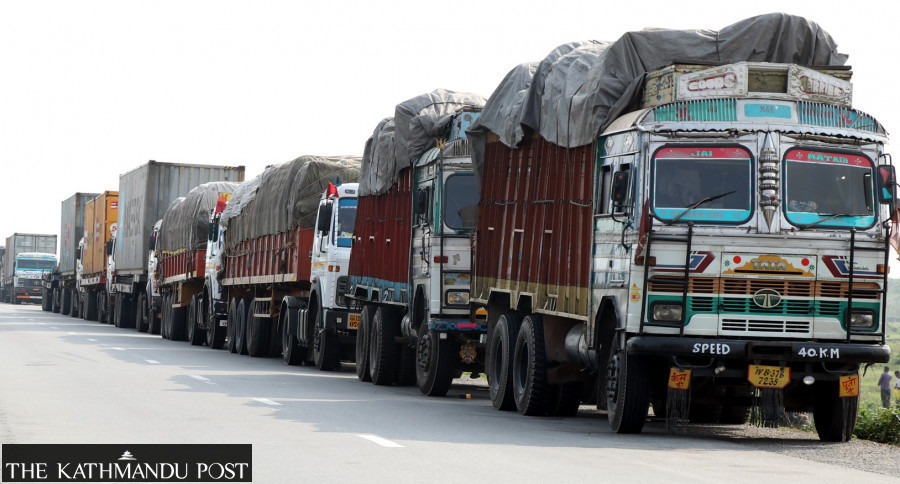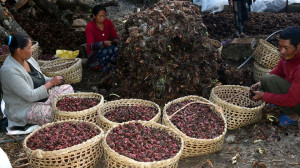Money
Nepal’s food import bill hits Rs360 billion as India eases curbs
Rising reliance on foreign food signals national emergency, say experts, calling for scrapping reciprocity in trade treaty.
Sangam Prasain
Imports of raw and processed agricultural goods have started to surge again following India’s easing of export restrictions on key food items.
This uptick has been further fueled by Nepal’s re-exports of edible oils to India by leveraging tariff loopholes between the two countries.
In the last fiscal year 2024-25, which ended on July 16, Nepal's agricultural import bill soared to a staggering Rs360 billion ($2.57 billion).
India has intermittently banned the export of essential staples such as wheat, rice, sugar, onions, and paddy, citing domestic supply concerns. These policies have directly influenced Nepal’s import patterns.
In fiscal year 2019–20, Nepal’s agricultural imports were just over Rs250 billion.The Covid pandemic briefly slowed this growth in 2020–21 due to border closures and lockdowns.
Since the outbreak of the Russia-Ukraine war, India has increasingly restricted rice exports to protect its domestic supply, imposing quotas and outright bans on items like rice and paddy.
Nepal’s trade policies also play a role. Before India’s rice export ban, informal traders often circumvented Nepal’s import duties, which included a 9 percent agriculture reform fee and a 2.5 percent advance income tax, resulting in a total 11.5 percent duty on homegrown rice.
By fiscal year 2021–22, imports had ballooned to Rs400 billion, prompting experts to sound the alarm. A farming country becoming so dependent on food imports indicates a full-blown emergency, experts warned.
In stark contrast, in 2001, Nepal’s food and agricultural imports from India were valued at just $11.84 million.
According to data from the Department of Customs, the rise in the import bill is mainly attributed to edible oil and cereals. Nepal imported 958,901 tonnes of crude palm, sunflower, and soybean oil, valued at Rs144.79 billion—contributing to a 13.25 percent year-on-year increase in total imports, which reached Rs1.80 trillion in the last fiscal year.
Of this, crude soyabean oil alone accounted for Rs108.95 billion. Nepal produces very little soyabean domestically. Imports of crude sunflower oil stood at Rs29 billion, and crude palm oil at Rs7.52 billion.
Taking advantage of the South Asian Free Trade Area (SAFTA) agreement, which allows zero tariffs on goods exported from underdeveloped countries like Nepal, traders have been importing crude soybean oil at low tariffs and re-exporting the refined oil to India duty-free.
After edible oil, cereal products top the list of imports. Nepal imported paddy and rice worth Rs43.42 billion—including paddy (Rs20.35 billion), basmati rice (Rs10.55 billion), and other rice varieties (Rs12.50 billion). However, this is still below the Rs79 billion worth of these edibles imported in 2021–22.
Imports of chemical fertilisers amounted to Rs32.28 billion in the last fiscal year.
Maize and maize seed imports totalled Rs18.50 billion, while Colza seed (rapeseed) oil imports reached Rs15 billion. Among fruits, apple imports topped the list, costing Rs12.16 billion.
“There is a reciprocity agreement in agricultural products between Nepal and India under the free trade regime, and that’s driving up imports,” said Rabi Shankar Sainju, a trade expert. “Due to India’s massive subsidies in agriculture, their production costs are low, and the products flood into Nepal.”
“That’s not a good sign for an agricultural country like Nepal,” he added.
Under the Nepal-India trade treaty, both countries, based on mutual agreement, allow certain agricultural products to be traded without taxes or limits. If India gives Nepali agricultural goods free access to its market, Nepal too should do the same for Indian goods.
Sainju argued that Nepali farmers cannot compete against India’s heavily subsidised products and called for an amendment to the trade treaty to remove the reciprocity system. He urged the government to focus on boosting domestic agricultural production.
Agricultural imports have been a significant contributor to Nepal’s expanding trade deficit. While imports surged past Rs1.8 trillion, exports remained stagnant at Rs277 billion, resulting in a 6 percent increase in the trade deficit year-on-year.
“This shows that the country’s agriculture policies are not working well,” Sainju said.
In 2009–10, the agricultural import bill was just Rs44.43 billion—a figure that has now increased nearly eightfold in a decade and a half.
Experts also note that the rise in remittances is driving consumption. In the first 11 months of the last fiscal year, migrant workers sent home Rs176.32 billion in remittances, up 15.5 percent year-on-year.
Market analysts observe that the growing demand for fine rice and maize is being driven by middle-income households who increasingly prefer long-grain basmati rice, which Nepal does not produce in adequate quantities.
Nepal also spent Rs8.38 billion on potatoes and Rs7 billion on garlic, while vegetable imports jumped to Rs38.50 billion.




 16.35°C Kathmandu
16.35°C Kathmandu















